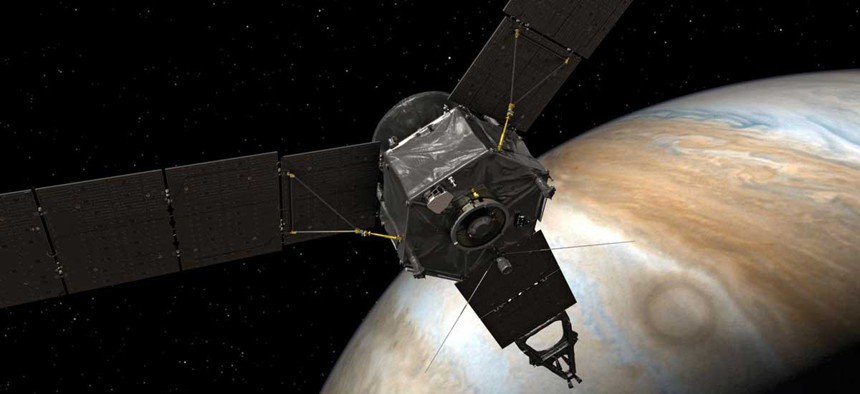
NASA/JPL-Caltech
How the Cold War Forced NASA to Make Its Jupiter Spacecraft Solar-powered
If NASA had its way, it would never have chosen this path.
NASA’s Juno spacecraft successfully entered an orbit around Jupiter this week. It will soon start revealing the secret life of the gas giant: whether it has a solid core or not, how much water there is in its atmosphere, and if there are more than 67 moons around it.
What’s even more remarkable is that it will do all this with only four 100-watt bulbs worth of power, which it will capture from the Sun using its huge wings made of nearly 20,000 solar cells. The achievement makes Juno the farthest solar-powered spacecraft from the Sun.
But if NASA had had its way, it would never have chosen this path.
The preferred form of power for deep-space exploration is a plutonium RTG (radioisotope thermoelectric generator). As the radioactive plutonium-238 decays, it emits alpha particles that generate heat. This heat is captured by special devices called thermocouples, which convert it into electricity.
RTGs are not very efficient, which means a lot of the heat that is released never gets converted to electricity. And yet, they remain a better choice than solar power because they provide a consistent amount of energy and do not require the spacecraft to be facing the Sun. Also, as you go farther from the Sun, the amount of energy solar cells can capture starts falling drastically. For instance, Jupiter receives only 4% as much solar energy per square meter as the Earth.
This is why all the previous NASA spacecrafts that have traveled beyond Mars—including Voyager, Cassini (around Saturn), and New Horizons (crossing Pluto)—have used a plutonium RTG.
But NASA had to ditch plans to put a plutonium RTG on Juno because the US didn’t have enough of the radioactive substance. From 1988, the US stopped producing plutonium-238, which had been primarily used for making nuclear warheads, as it signed arms treaties with the Soviet Union before the communist nation’s collapse in 1991.
The US began been dismantling some of its nuclear weapons’ stockpile, which gave NASA a steady supply of plutonium-238 that has been almost exhausted. The US won’t reveal just how much plutonium-238 it has left for strategic reasons, but rumors suggest that it only has enough left to power a handful of future spacecraft.
(The US has started finally manufacturing some more plutonium-238, but full-scale production is still many years away. The European Space Agency is also investigating the use of other types of radioactive material, such as Americium, to power RTGs.)
Fortunately, since NASA’s plutonium-powered Galileo visited Jupiter, the efficiency of solar cells had doubled. So when NASA started planning to build Juno in 2003, it could, for the first time, consider setting a new record with a solar-powered spacecraft.
This new record is likely to remain, because the next planet, Saturn, is a billion miles farther out from Jupiter. No matter how efficient solar cells become, they are unlikely to power missions beyond Jupiter.
NEXT STORY: The Federal Government Confronts Its Bias






